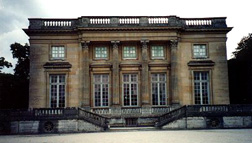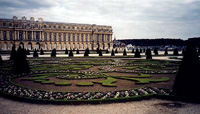![]()
In the Eighteenth Century
Since Louis XV (1715-1774) was still only a child when he assumed the throne on 9 September, he left Versailles for Vincennes. The regent, Philippe d'Orleans, moved to Paris, and the court settled in the Tuileries. In 1722, Louis XV (twelve years old) decided to go back to Versailles. During his reign, reconstruction of the palace continued with destruction (the bathing apartment and the ambassadors' staircase) and creation (the Hercules Room, the Opera and Small Trianon)--Around 1763, construction began on le Petit Trianon, and about 1770, Jacques-Ange Gabriel finished l'Opéra with its illusionistic mirrors--The apartments of the king, queen and the princes changed to comply with contemporary taste.

In the reign of Louis XVI (1774-1792) plans for the further reconstruction of the palace ended with the Revolution. It was at Versailles that the États Généraux met on 5 May 1789, and on 20 June the deputies of the Third Estate swore le Serment du Jeu de Paume. On 5-6 October the Parisian crowd invaded the château, and the royal family abandoned Versailles for Paris.
As the revolutionary era unfolded, the paintings, antiques and jewels of Versailles went to the Musée du Louvre, books and medals went to the Bibliothèque Nationale, clocks and scientific instruments to the School of Arts and Crafts. The furniture was sold at public auction. With the proclamation of the Empire the palace became an official residence of the crown, but Napoléon abdicated before being able to spend any significant length of time there.
After the Revolution
After the French Revolution, Versailles gave way to the Tuileries in Paris as the royal residence. Louis-Philippe saved the château from certain ruin at his own expense and transformed it into the "Musée d'Histoire à toutes les gloires de la France" (1837). He kept the Chapel, the Opera, the Hall of Mirrors and the major part of the decoration of the royal apartments, but in order to create vast exhibition halls, he removed most of the apartments of the princes and courtiers.
In 1870, to the rising anger of the French, the Prussians occupied the palace and used it as one of their headquarters. The German Empire was proclaimed in the Galerie des Glaces.
Before the Revolution the royal estate of Versailles covered more than twenty thousand acres, completely surrounded by a wall and with three distinct areas: the gardens, the Small Park (with the Swiss Pool, Grand Canal, Menagerie and the Trianon) and the Great Park, reserved for hunting. Split up at the Revolution, with a large part of confiscated, today the domain is only about two thousand acres. Lost, besides part of the "Little Park" was the entire Big Park. Still the palace stretches for almost a half mile, and at its peak it held enough rooms to house the entire royal court (maybe 10,000 people).
